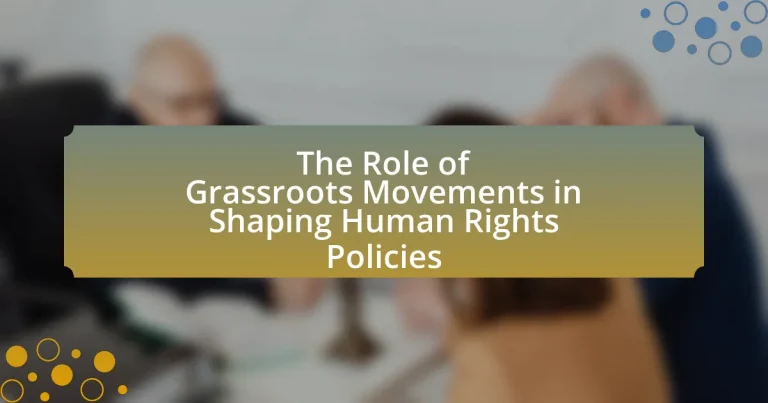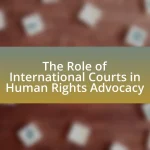Grassroots movements are organized efforts by ordinary individuals at the community level aimed at advocating for social change, particularly in the realm of human rights. This article examines the significance of grassroots movements in shaping human rights policies, highlighting their ability to mobilize communities, raise awareness, and influence legislative changes through collective action. Key historical examples, such as the Civil Rights Movement in the United States and the anti-apartheid movement in South Africa, illustrate the impact of grassroots activism on policy reforms. The article also explores the strategies employed by these movements, including coalition-building and the use of social media, as well as the challenges they face in navigating political environments and securing funding.
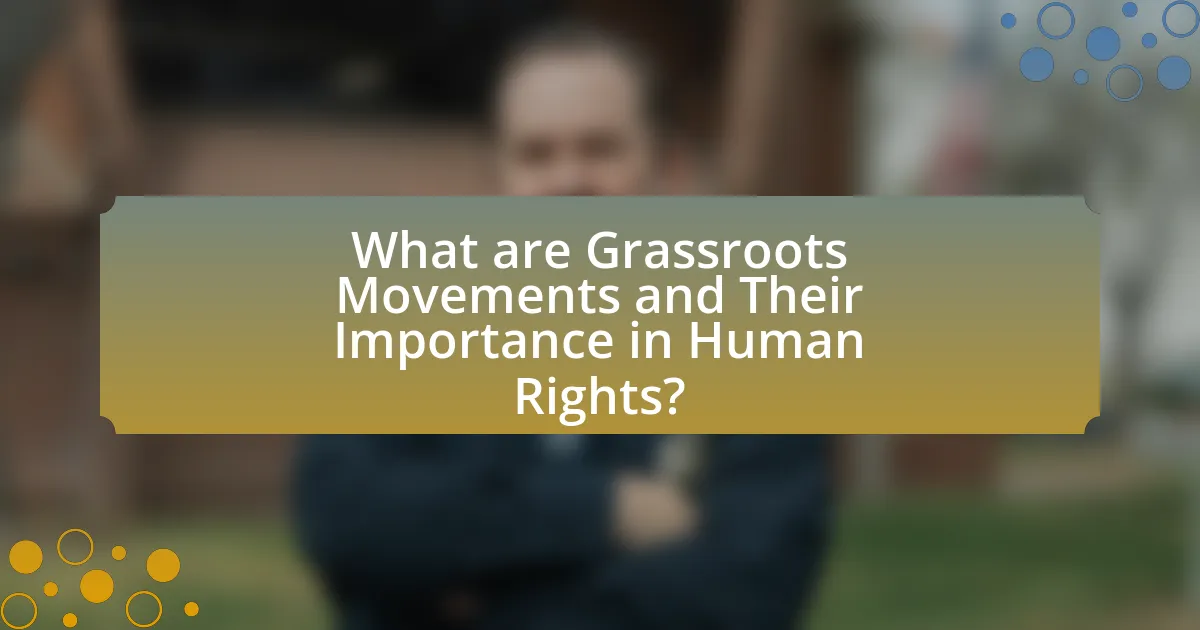
What are Grassroots Movements and Their Importance in Human Rights?
Grassroots movements are organized efforts by ordinary people at the community level to advocate for social change, often focusing on human rights issues. These movements are crucial in human rights because they mobilize local populations, raise awareness about injustices, and influence policy changes through collective action. For instance, the Civil Rights Movement in the United States, which began in the 1950s, exemplifies how grassroots activism can lead to significant legislative changes, such as the Civil Rights Act of 1964, which aimed to eliminate discrimination based on race, color, religion, sex, or national origin. This demonstrates that grassroots movements not only empower individuals but also play a vital role in shaping human rights policies and promoting social justice.
How do grassroots movements influence human rights policies?
Grassroots movements influence human rights policies by mobilizing community support, raising awareness, and advocating for change at local, national, and international levels. These movements often highlight injustices and bring marginalized voices to the forefront, compelling policymakers to address issues such as discrimination, inequality, and violence. For instance, the Civil Rights Movement in the United States led to significant legislative changes, including the Civil Rights Act of 1964 and the Voting Rights Act of 1965, demonstrating how organized grassroots efforts can result in concrete policy shifts. Additionally, grassroots campaigns like the #MeToo movement have reshaped discussions around sexual harassment and assault, leading to policy reforms in workplaces and legal systems.
What historical examples illustrate the impact of grassroots movements on human rights?
Grassroots movements have significantly impacted human rights, with notable examples including the Civil Rights Movement in the United States and the anti-apartheid movement in South Africa. The Civil Rights Movement, particularly from the 1950s to the 1960s, mobilized citizens to challenge racial segregation and discrimination, leading to landmark legislation such as the Civil Rights Act of 1964 and the Voting Rights Act of 1965. These laws were direct outcomes of grassroots activism, including protests, sit-ins, and the leadership of figures like Martin Luther King Jr.
Similarly, the anti-apartheid movement in South Africa, which gained momentum in the 1980s, involved widespread grassroots organizing, protests, and international solidarity campaigns. This movement ultimately contributed to the dismantling of apartheid and the establishment of a democratic government in 1994, marked by Nelson Mandela’s election as president. Both movements exemplify how grassroots efforts can lead to substantial changes in human rights policies and societal norms.
How do grassroots movements mobilize communities for human rights advocacy?
Grassroots movements mobilize communities for human rights advocacy by fostering local engagement and empowering individuals to take collective action. These movements often utilize community organizing strategies, such as door-to-door outreach, public meetings, and social media campaigns, to raise awareness about human rights issues and galvanize support. For instance, the Civil Rights Movement in the United States effectively mobilized communities through grassroots organizing, leading to significant legislative changes like the Civil Rights Act of 1964. By creating networks of support and providing resources, grassroots movements enable individuals to advocate for their rights and influence policy changes at local, national, and international levels.
Why are grassroots movements essential for social change?
Grassroots movements are essential for social change because they empower individuals and communities to advocate for their rights and influence policy decisions. These movements often arise from the collective experiences and needs of marginalized groups, enabling them to mobilize resources, raise awareness, and create pressure for change. Historical examples, such as the Civil Rights Movement in the United States, demonstrate how grassroots activism can lead to significant legislative reforms, including the Civil Rights Act of 1964, which was a direct result of sustained grassroots efforts. Additionally, grassroots movements foster civic engagement and build solidarity among diverse populations, making them crucial for driving social justice and human rights advancements.
What role do grassroots movements play in raising awareness about human rights issues?
Grassroots movements play a crucial role in raising awareness about human rights issues by mobilizing communities and amplifying marginalized voices. These movements often utilize social media, local events, and community organizing to educate the public and advocate for change. For instance, the Black Lives Matter movement has effectively highlighted systemic racism and police brutality, leading to widespread protests and policy discussions across the globe. Research indicates that grassroots activism can significantly influence public opinion and policy decisions, as seen in the 2018 Women’s March, which brought millions together to advocate for gender equality and reproductive rights.
How do grassroots movements empower marginalized communities?
Grassroots movements empower marginalized communities by providing a platform for collective action and amplifying their voices in societal discourse. These movements facilitate community organization, enabling individuals to unite around shared issues such as social justice, economic inequality, and human rights violations. For instance, the Civil Rights Movement in the United States mobilized African Americans and allies to challenge systemic racism, leading to significant legislative changes like the Civil Rights Act of 1964. This historical example illustrates how grassroots efforts can influence policy and create lasting change, demonstrating the effectiveness of community-driven initiatives in advocating for marginalized groups.
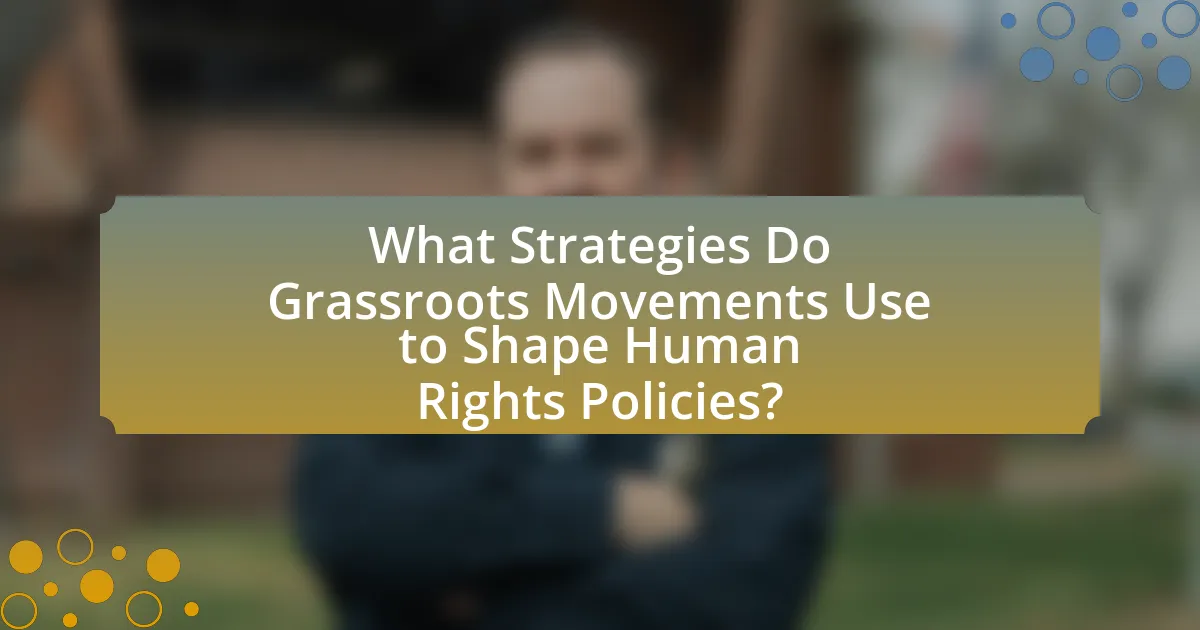
What Strategies Do Grassroots Movements Use to Shape Human Rights Policies?
Grassroots movements employ various strategies to shape human rights policies, including advocacy, mobilization, coalition-building, and public awareness campaigns. Advocacy involves lobbying policymakers and engaging in direct dialogue to influence legislation, as seen in the Civil Rights Movement, which successfully pushed for the Civil Rights Act of 1964 through persistent advocacy efforts. Mobilization refers to organizing community members to participate in protests, demonstrations, and other forms of collective action, exemplified by the Women’s March, which galvanized millions to advocate for gender equality and women’s rights. Coalition-building allows grassroots movements to unite diverse groups, amplifying their voices and increasing their impact, as demonstrated by the collaboration between environmental and social justice organizations during the climate justice movement. Public awareness campaigns utilize social media and traditional media to educate the public and raise consciousness about human rights issues, effectively shaping public opinion and pressuring governments to act, as evidenced by the #MeToo movement, which brought global attention to sexual harassment and assault. These strategies collectively empower grassroots movements to influence human rights policies effectively.
How do grassroots movements utilize social media for advocacy?
Grassroots movements utilize social media for advocacy by leveraging platforms to mobilize supporters, disseminate information, and amplify their messages. These movements create online campaigns that engage users through hashtags, shareable content, and targeted messaging, which can rapidly spread awareness about specific issues. For instance, the #MeToo movement effectively used Twitter to highlight sexual harassment and assault, leading to widespread public discourse and policy discussions. Additionally, social media allows grassroots organizations to connect with a global audience, facilitating fundraising and collaboration with other groups, thereby enhancing their impact on human rights policies.
What are the advantages of using social media in grassroots campaigns?
The advantages of using social media in grassroots campaigns include enhanced outreach, cost-effectiveness, and real-time engagement. Social media platforms allow grassroots movements to reach a larger audience quickly, facilitating the dissemination of information and mobilization of supporters. For instance, campaigns like the Ice Bucket Challenge in 2014 raised over $115 million for ALS research through viral social media engagement. Additionally, social media is a low-cost alternative to traditional advertising, enabling organizations with limited budgets to effectively promote their causes. Real-time engagement fosters community building and allows for immediate feedback, which can strengthen the campaign’s message and adapt strategies based on audience reactions.
How can social media amplify grassroots messages to a wider audience?
Social media amplifies grassroots messages to a wider audience by providing platforms for rapid dissemination and engagement. These platforms enable grassroots movements to share their narratives, mobilize supporters, and create viral content that reaches beyond traditional media boundaries. For instance, the #MeToo movement gained global traction through social media, allowing individuals to share personal stories and connect with a larger community, which led to significant societal discussions and policy changes regarding sexual harassment. This demonstrates how social media can effectively elevate grassroots messages, making them accessible to diverse audiences and fostering collective action.
What types of coalitions do grassroots movements form?
Grassroots movements form various types of coalitions, including issue-based coalitions, identity-based coalitions, and strategic alliances. Issue-based coalitions focus on specific social or political issues, such as environmental justice or healthcare reform, uniting diverse groups around a common cause. Identity-based coalitions bring together individuals and organizations that share a common identity, such as racial or ethnic groups, to advocate for their rights and interests. Strategic alliances involve collaboration between grassroots movements and established organizations or institutions to amplify their impact and resources. These coalitions are essential for mobilizing support, sharing resources, and increasing visibility for their causes, thereby enhancing their effectiveness in shaping human rights policies.
How do alliances with other organizations enhance the effectiveness of grassroots movements?
Alliances with other organizations enhance the effectiveness of grassroots movements by providing additional resources, expertise, and broader networks for advocacy. These partnerships enable grassroots movements to amplify their message, reach larger audiences, and gain credibility through association with established entities. For instance, the collaboration between grassroots organizations and larger NGOs during the 2011 Arab Spring demonstrated how alliances can mobilize international attention and support, leading to significant political changes. Such strategic partnerships often result in increased funding, shared knowledge, and coordinated campaigns, ultimately strengthening the impact of grassroots efforts in shaping human rights policies.
What challenges do grassroots movements face when forming coalitions?
Grassroots movements face several challenges when forming coalitions, primarily including differing priorities, resource limitations, and organizational structures. Differing priorities can lead to conflicts over goals and strategies, making it difficult to establish a unified agenda. Resource limitations, such as funding and manpower, hinder the ability to collaborate effectively, as many grassroots organizations operate on tight budgets and volunteer support. Additionally, varying organizational structures and cultures can create barriers to communication and coordination, complicating the coalition-building process. These challenges are evident in historical examples, such as the difficulties faced by the civil rights movement in the United States, where diverse groups struggled to align their objectives despite a common goal of racial equality.
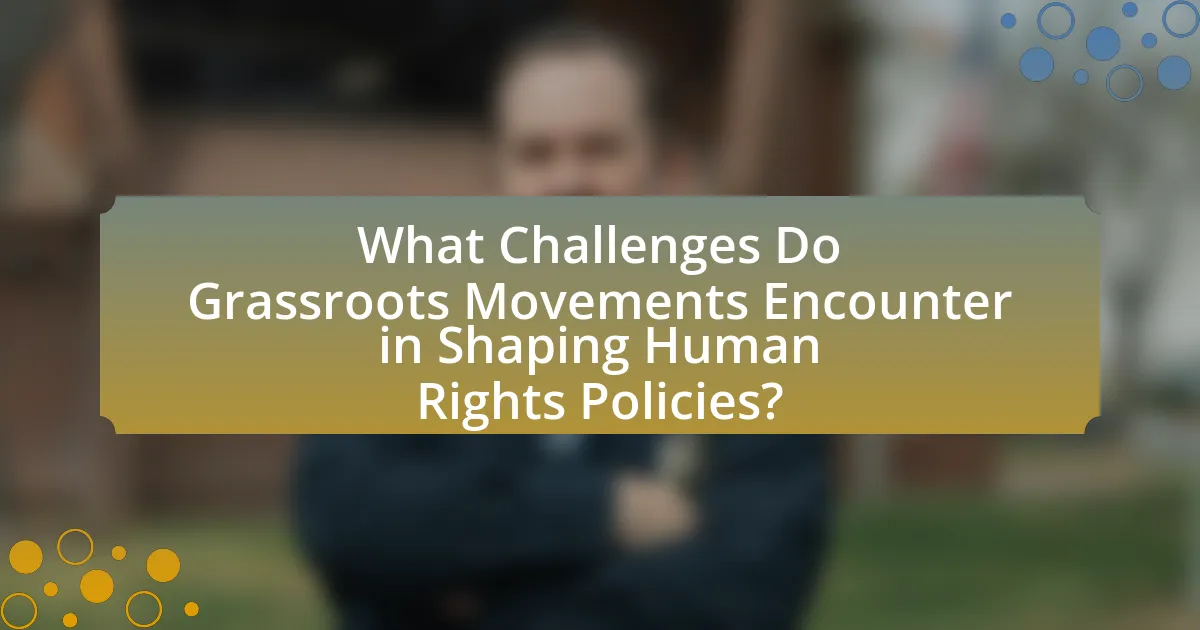
What Challenges Do Grassroots Movements Encounter in Shaping Human Rights Policies?
Grassroots movements encounter significant challenges in shaping human rights policies, primarily due to limited resources, political resistance, and lack of visibility. Limited financial and human resources hinder their ability to mobilize effectively and sustain long-term campaigns. Political resistance often manifests through pushback from established power structures, which may view grassroots initiatives as threats to their authority. Additionally, grassroots movements frequently struggle with visibility in mainstream media, making it difficult to garner public support and influence policy discussions. For instance, the Black Lives Matter movement faced substantial opposition from law enforcement and political figures, which impeded its efforts to enact comprehensive police reform. These challenges illustrate the complex landscape grassroots movements navigate in their pursuit of meaningful human rights policy changes.
How do political environments affect grassroots movements?
Political environments significantly influence grassroots movements by shaping their strategies, goals, and overall effectiveness. In repressive political climates, grassroots movements often face challenges such as censorship, limited funding, and government opposition, which can hinder their ability to mobilize support and achieve objectives. For instance, during the Arab Spring, activists utilized social media to organize protests against authoritarian regimes, demonstrating how a restrictive political environment can spur innovative tactics for grassroots mobilization. Conversely, in more open political environments, grassroots movements may benefit from greater access to resources, public support, and the ability to engage with policymakers, as seen in the civil rights movement in the United States, where supportive political contexts allowed for significant legislative changes. Thus, the political environment acts as a critical determinant of the strategies and success of grassroots movements in advocating for human rights policies.
What strategies can grassroots movements employ to navigate hostile political climates?
Grassroots movements can employ coalition-building, strategic communication, and community engagement to navigate hostile political climates. Coalition-building allows these movements to unite with other organizations and groups, amplifying their voice and resources, as seen in the successful collaboration of various civil rights organizations during the 1960s. Strategic communication involves crafting clear, compelling messages that resonate with the public and counteract negative narratives, which has been effective in movements like Black Lives Matter. Community engagement fosters local support and mobilizes grassroots efforts, exemplified by the success of the Women’s March in 2017, which drew millions of participants worldwide. These strategies collectively enhance resilience and adaptability in challenging political environments.
How do legal barriers impact the effectiveness of grassroots movements?
Legal barriers significantly hinder the effectiveness of grassroots movements by restricting their ability to organize, mobilize, and advocate for change. For instance, laws that limit freedom of assembly or impose strict regulations on protests can prevent grassroots organizations from gathering support and raising awareness about human rights issues. Historical examples include the Civil Rights Movement in the United States, where legal restrictions on protests and voter registration efforts were challenged, illustrating how such barriers can provoke legal battles that divert resources and attention from core advocacy goals. Additionally, legal frameworks that criminalize dissent can lead to intimidation and repression, further stifling grassroots initiatives aimed at influencing human rights policies.
What internal challenges do grassroots movements face?
Grassroots movements face several internal challenges, including resource limitations, leadership conflicts, and maintaining member engagement. Resource limitations often hinder their ability to mobilize effectively, as many rely on volunteer efforts and small donations, which can restrict their outreach and impact. Leadership conflicts can arise when differing visions or strategies create divisions within the movement, potentially leading to fragmentation and reduced effectiveness. Additionally, maintaining member engagement is crucial; as enthusiasm wanes over time, movements may struggle to sustain momentum and participation, which is essential for achieving their goals. These challenges can significantly impact the overall effectiveness of grassroots movements in shaping human rights policies.
How can grassroots movements maintain cohesion and focus among diverse members?
Grassroots movements can maintain cohesion and focus among diverse members by establishing clear, shared goals and fostering open communication. Clear goals provide a unified direction, which is essential for aligning the varied interests of members. For instance, the Civil Rights Movement in the United States effectively united diverse groups by focusing on the common objective of racial equality, which helped to streamline efforts and resources. Open communication encourages inclusivity and allows for the expression of different perspectives, which can enhance collaboration. Research indicates that organizations with strong communication practices are more successful in achieving their objectives, as seen in studies by the Harvard Business Review, which highlight the importance of transparency and dialogue in team dynamics.
What role does funding play in the sustainability of grassroots movements?
Funding is crucial for the sustainability of grassroots movements as it provides the necessary resources for operations, outreach, and advocacy efforts. Without adequate financial support, these movements struggle to maintain momentum, organize events, and engage with their communities effectively. For instance, a study by the National Committee for Responsive Philanthropy found that grassroots organizations that receive funding are more likely to achieve their goals and influence policy changes. Additionally, funding enables these movements to hire staff, develop campaigns, and sustain long-term initiatives, which are essential for creating lasting impact in human rights policies.
What are best practices for grassroots movements to effectively influence human rights policies?
Grassroots movements can effectively influence human rights policies by employing strategic coalition-building, grassroots mobilization, and targeted advocacy campaigns. Coalition-building allows diverse groups to unite around common goals, amplifying their collective voice; for example, the Civil Rights Movement in the United States successfully brought together various organizations to challenge systemic racism. Grassroots mobilization engages community members directly, fostering local support and participation, as seen in the global climate justice movement, which has mobilized millions to advocate for environmental and human rights. Targeted advocacy campaigns, such as those led by Amnesty International, utilize research and data to highlight human rights abuses, pressuring policymakers to enact change. These practices demonstrate that organized, community-driven efforts can lead to significant policy shifts and improvements in human rights protections.
How can grassroots movements measure their impact on human rights policies?
Grassroots movements can measure their impact on human rights policies through quantitative and qualitative assessments, including tracking policy changes, public opinion shifts, and engagement metrics. For instance, they can analyze legislative records to identify the introduction or amendment of laws influenced by their advocacy efforts, such as the passing of the Violence Against Women Act in the United States, which was significantly shaped by grassroots activism. Additionally, surveys and polls can gauge public sentiment before and after campaigns, providing data on shifts in awareness and support for specific human rights issues. Furthermore, case studies documenting specific campaigns, like the Black Lives Matter movement’s influence on police reform policies, serve as concrete evidence of their impact.
What resources are available for grassroots movements to enhance their advocacy efforts?
Grassroots movements can enhance their advocacy efforts through various resources, including funding opportunities, training programs, and digital tools. Funding sources such as grants from foundations like the Ford Foundation or the Open Society Foundations provide financial support for initiatives. Training programs offered by organizations like the Grassroots Institute for Fundraising Training equip activists with skills in fundraising and advocacy strategies. Additionally, digital tools such as social media platforms and online petition sites enable grassroots movements to reach wider audiences and mobilize support effectively. These resources collectively empower grassroots movements to influence human rights policies and drive social change.
